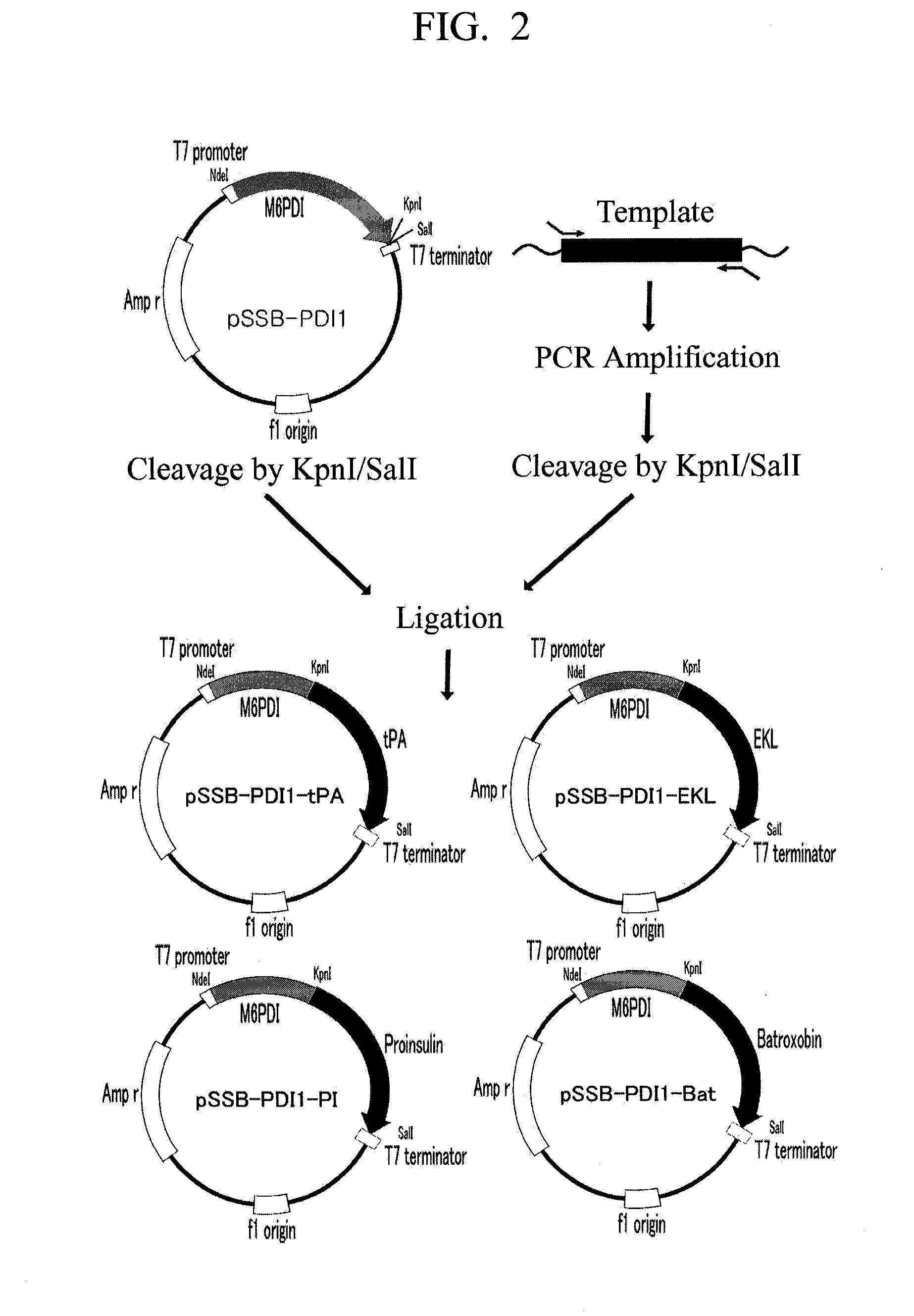Method for preparing soluble and active recombinant proteins using pdi as a fusion partner
a fusion partner and recombinant protein technology, applied in the field of preparing soluble and active recombinant proteins using pdi as a fusion partner, can solve the problems of large amount of time and expense required for finding effective refolding conditions, difficult or impossible to refold a majority of high molecular weight proteins, and high equipment requirements. , to achieve the effect of stable protein production, low solubility of expressed proteins, and high expression ra
- Summary
- Abstract
- Description
- Claims
- Application Information
AI Technical Summary
Benefits of technology
Problems solved by technology
Method used
Image
Examples
embodiment 1
Construction of pSSB-PDI1 Plasmid Vector
[0037]A molecular genetic technique used in the present invention is based on a literature [Ausubel, F. M. et al. (Ed.), J. Wiley Sons, Curr. Protocols in Molecular Biology, 1997]. Primers used for a polymerase chain reaction (PCR) were ordered and synthesized at Bioneer Corp., rTaq polymerase was commercially available from TaKaRa, and PCR was carried out according to a standard condition presented by a TaKaRa's manual protocol.
[0038]A PDI gene was cloned by carrying out PCR using cDNA of a rat PDI gene as a template. A fusion protein was designed so that a sequence of 6 amino acid residues (M6) existing in an amino-terminal domain of maltose-binding protein was added to an amino terminus of a PDI protein so as to enhance an expression rate of a PDI protein, and a peptide sequence containing 6 aspartic acid and glutamic acid residues and a linker amino acid residue was added to a carboxyl terminus of the PDI protein for the purpose of its eas...
embodiment 2
Construction of Expression Plasmid for Production of Tissue-Type Plasminogen Activator in Form of Fusion Protein
[0041]A human tissue-type plasminogen activator (hereinafter, referred to as “tPA”) gene was used as a template, and a genetically modified tPA was also used as a template to enhance an expression rate of a target protein considering codon usage.
[0042]In order to produce the target protein in a form of fusion protein and remove a fusion partner from the fusion protein, a tPA gene containing a DNA sequence at its 5′-terminus was amplified with a PCR method using primers set forth in SEQ ID NOs: 5 and 6, the DNA sequence encoding an amino acid sequence recognized by TEV enzyme.
[0043]1 μg of the amplified DNA fragment was dissolved in 50 μl TE (pH 8.0) solution, and mixed with 2 units of KpnI (NEB), and then the resultant mixture was reacted at 37° C. for 6 hours, and only a DNA fragment was purified with a DNA purification kit (Intron). Also, the purified DNA was dissolved i...
embodiment 3
Construction of Expression Plasmid for Production of EKL in Form of Fusion Protein
[0044]EKL is a light chain domain which is an active region of the protease, bovine enterokinase, and only the light chain of the bovine enterokinase was used as a template to clone an EKL gene.
[0045]In order to produce the target protein in a form of fusion protein and remove a fusion partner from the fusion protein, an EKL gene was amplified with a PCR method using primers set forth in SEQ ID NOs: 7 and 8, the EKL gene containing a DNA sequence, which encodes an amino acid sequence (DDDDK) recognized by EKL enzyme, at its amino-terminal domain, and a DNA sequence containing 6 histidine residues at its carboxyl-terminal domain for the purpose of improving its purification.
[0046]The amplified DNA fragment was inserted between sites of the plasmid pSSB-PDI1 recognized by restriction enzymes KpnI and SalI in the same manner as in Embodiment 2. The plasmid vector prepared thus was named pSSB-PDI1-EKL (see...
PUM
| Property | Measurement | Unit |
|---|---|---|
| Dynamic viscosity | aaaaa | aaaaa |
Abstract
Description
Claims
Application Information
 Login to View More
Login to View More - R&D
- Intellectual Property
- Life Sciences
- Materials
- Tech Scout
- Unparalleled Data Quality
- Higher Quality Content
- 60% Fewer Hallucinations
Browse by: Latest US Patents, China's latest patents, Technical Efficacy Thesaurus, Application Domain, Technology Topic, Popular Technical Reports.
© 2025 PatSnap. All rights reserved.Legal|Privacy policy|Modern Slavery Act Transparency Statement|Sitemap|About US| Contact US: help@patsnap.com



